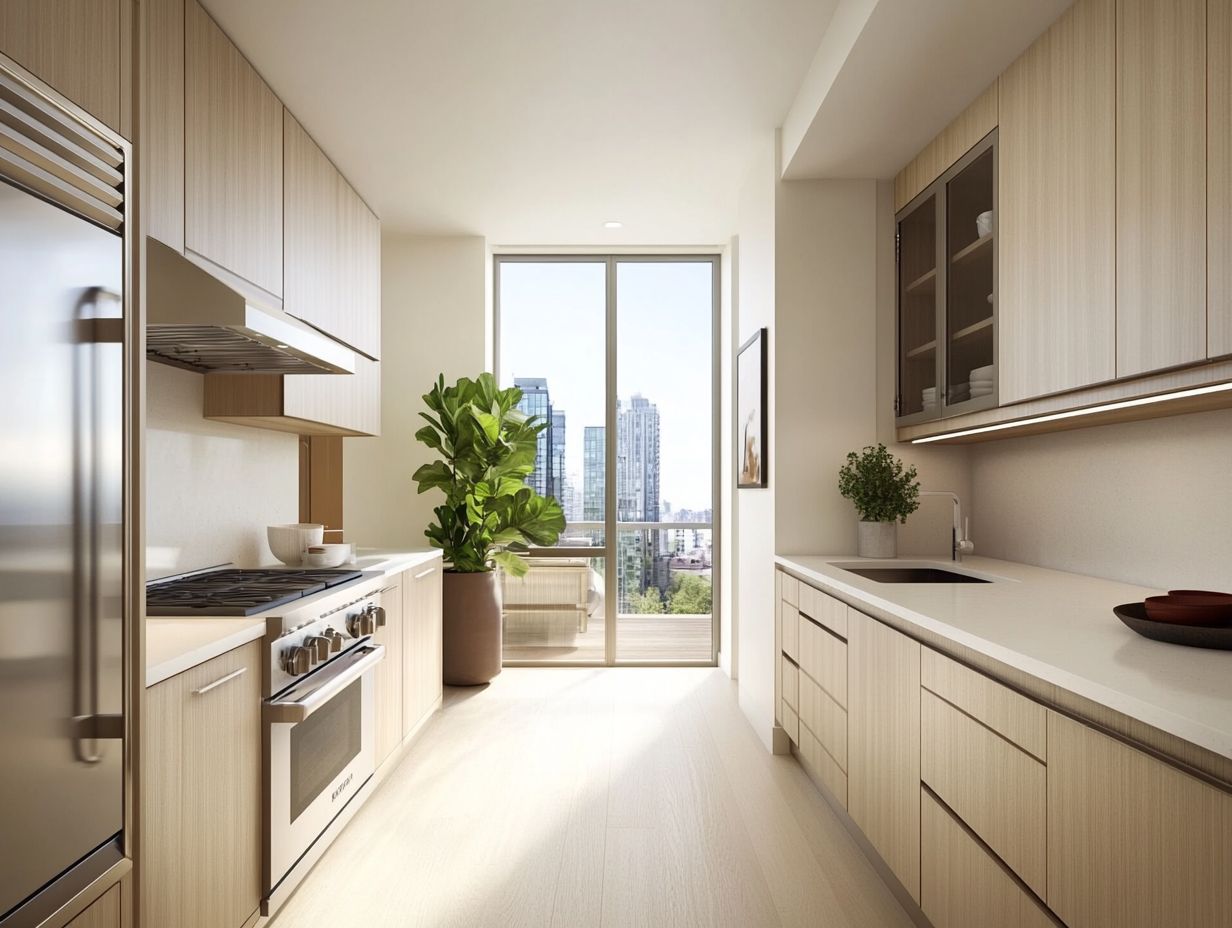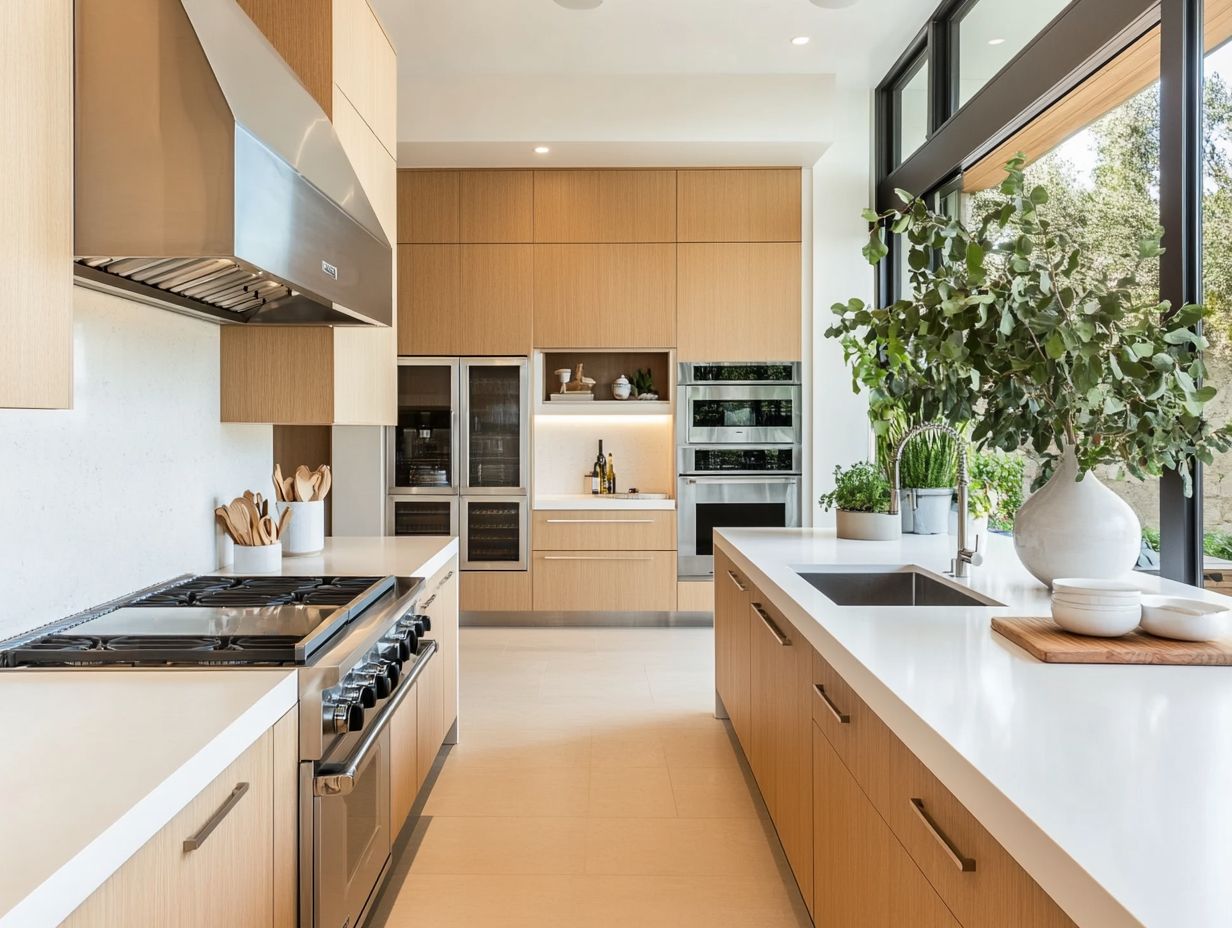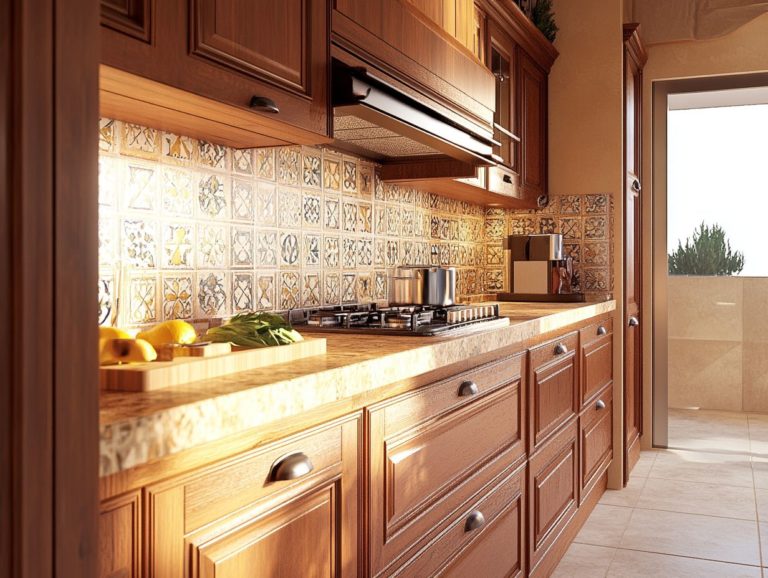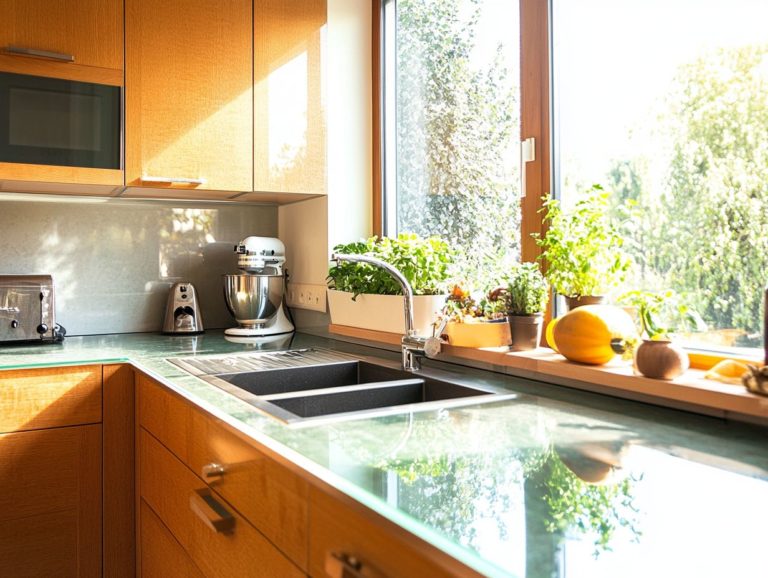Choosing Materials for a Minimalist Kitchen
In today’s fast-paced world, a minimalist kitchen provides a breath of fresh air. It seamlessly blends efficiency with style.
This exploration highlights the benefits of embracing minimalism in kitchen design. It shows how this approach elevates aesthetics and sustainability.
You’ll learn how to select durable materials and essential tools. These choices promote functionality while keeping clutter at bay.
You’ll uncover tips for organizing and maintaining your minimalist space. This ensures it remains a sanctuary for your culinary creativity.
Dive in! Discover how to transform your kitchen into a streamlined haven, where simplicity meets elegance.
Contents
- Key Takeaways:
- Benefits of a Minimalist Kitchen
- Choosing Materials for a Minimalist Kitchen
- Essential Items for a Minimalist Kitchen
- Organizing a Minimalist Kitchen
- Maintaining a Minimalist Kitchen
- Frequently Asked Questions
- What materials work best for a minimalist kitchen?
- How do I choose the right materials for my minimalist kitchen?
- Are there any materials to avoid for a minimalist kitchen?
- What are the benefits of using natural materials in a minimalist kitchen?
- What should I keep on my kitchen counter for a minimalist look?
- Can I mix and match materials in my minimalist kitchen?
- Is it worth investing in high-quality materials for a minimalist kitchen?
Key Takeaways:

Minimalism in the kitchen leads to efficiency, aesthetics, and sustainability.
Choose durable and sustainable materials for a minimalist kitchen, considering cost as well.
Essential items and organization are key to maintaining a minimalist kitchen. Regular cleaning and decluttering are necessary.
Defining Minimalism in Kitchen Design
Minimalism in kitchen design focuses on being simple and functional. It showcases a clean aesthetic while reducing visual clutter.
By honing in on essential kitchen items and eliminating distractions, your minimalist kitchen fosters efficient organization and optimal use of space.
This intentional approach transforms your cooking experience, as every food container and essential tool finds its rightful place. This promotes a sense of calm and clarity.
For example, opting for stackable storage solutions allows you to maximize vertical space. Every pot, pan, and utensil remains easily accessible.
A minimalist kitchen often incorporates eco-friendly materials. This contributes to sustainability while exuding refined elegance.
Whether you choose bamboo utensils or glass containers, prioritizing quality over quantity leads to a more organized and efficient workspace.
Embracing minimalism enhances the visual appeal of your kitchen and nurtures a smoother, more mindful cooking process.
Benefits of a Minimalist Kitchen
The benefits of a minimalist kitchen go well beyond just looking good. They include enhanced efficiency, a soothing atmosphere, and a sustainable lifestyle that resonates with contemporary living.
By trimming down to only the essential cooking equipment, a minimalist kitchen helps you reduce clutter. This simplifies your cooking processes, making meal prep and family gatherings a breeze.
The clean lines and selected kitchen gadgets create an appealing environment. This inspires creativity in your culinary adventures while encouraging responsible food storage and waste management practices.
Efficiency, Aesthetics, and Sustainability
In a minimalist kitchen, efficiency, aesthetics, and sustainability converge seamlessly. Each element is curated to serve a specific purpose, elevating your overall cooking experience.
Imagine a space where every item—whether a multifunctional cooking appliance or an efficient organization system—holds significance.
For example, using clear, labeled storage containers keeps your ingredients visible and accessible. This cuts down on the time you spend searching for frequently used items.
Let’s not overlook the sleek induction cooktop. It enhances the modern aesthetic and boosts energy efficiency.
By cultivating a sense of order and beauty, your minimalist kitchen inspires mindful cooking. This approach often leads to reduced food waste and encourages the use of sustainable cleaning tools crafted from eco-friendly materials.
Choosing Materials for a Minimalist Kitchen
Selecting the right materials for your minimalist kitchen is essential for longevity and an eco-conscious approach.
By choosing durable materials, you elevate the aesthetic appeal of your space. Additionally, you ensure that your kitchen can withstand the demands of daily use, paving the way for a successful renovation.
Opting for sustainable choices like reclaimed wood and eco-friendly finishes fosters a healthier living environment. This aligns perfectly with the minimalist philosophy, emphasizing simplicity and responsibility in kitchen design.
Durable and Sustainable Options

Durable and sustainable choices are key in a minimalist kitchen. They combine longevity with eco-friendliness in your cooking tools.
When you select materials like stainless steel, bamboo, and glass, you enhance the functionality of your kitchen items while reducing your environmental impact. This approach allows you to seamlessly integrate sustainable practices into your daily cooking routines.
These smart choices contribute to a cleaner kitchen aesthetic and promote efficient resource use. Stainless steel, known for its resistance to rust and corrosion, features prominently in various utensils, pots, and food containers, ensuring they stand the test of time.
Bamboo, a rapidly renewable resource, makes an excellent choice for cutting boards and utensils. It offers a natural feel while being gentle on your knife edges.
Glass food containers present a non-toxic option for storing leftovers, as they don’t leach harmful chemicals. Their transparency aids in maintaining an organized kitchen.
By incorporating these materials, you support smart choices that make your kitchen easier to manage, crafting an inviting space that is both functional and environmentally mindful.
Cost Considerations
Cost considerations are pivotal for achieving your dream minimalist kitchen. Investing in top-notch appliances and tools might cost more upfront, but you’ll save in the long run!
While durable materials and tools that do more than one job might seem pricier at first, their efficiency and reduced replacement costs are worth it for any kitchen renovation. By prioritizing quality over quantity, you can create a minimalist kitchen that meets your culinary needs and aligns with your budgetary goals.
This strategy helps you spend wisely, allowing you to gradually transform your culinary space without racking up unnecessary expenses along the way. For example, opting for a refrigerator designed to use less electricity or a versatile induction cooktop can significantly lower your electricity bills over time, effectively balancing out their upfront costs.
Investing in quality cookware reduces food waste and minimizes the need for frequent replacements. A streamlined space means fewer items to clean and maintain, ultimately saving you valuable time and resources.
By being intentional with your choices, you can truly optimize your investment for lasting benefits in your minimalist kitchen.
Essential Items for a Minimalist Kitchen
Choose versatile and functional items for your minimalist kitchen. Each tool should serve multiple purposes to enrich your cooking experience.
Consider including high-quality pots and pans, a chef’s knife, and multifunctional kitchen gadgets that simplify meal prep while keeping clutter to a minimum.
This thoughtful approach not only streamlines your kitchen organization but also fosters a more enjoyable and efficient cooking environment, making it ideal for whipping up family meals.
Must-Have Tools and Appliances
Must-have tools and appliances for your minimalist kitchen are meticulously chosen to enhance efficiency while keeping clutter at bay. Essentials like an air fryer, blender, and measuring cups simplify meal preparation and provide versatile functionality, allowing you to explore various cooking techniques without overwhelming your kitchen space.
By integrating smart food storage containers, you can manage leftovers effectively, reducing food waste and elevating your kitchen organization.
Along with these essential appliances, a quality chef’s knife becomes your essential ally in meal prep, enabling you to chop, slice, and dice with precision and ease. A compact cutting board helps declutter, offering a dedicated space for food preparation that can be effortlessly cleaned and stored.
Cleaning utensils, such as a multifunctional scrubber and reusable dishcloths, help maintain cleanliness without occupying unnecessary space. Together, all these elements create a harmonious cooking environment where clutter control takes precedence, and each tool fulfills a distinct and vital role in your culinary experience.
Start your journey to a minimalist kitchen today and transform your cooking experience!
Organizing a Minimalist Kitchen
Organizing a minimalist kitchen requires deliberate strategies that prioritize clutter control and efficient use of space. Each item should have a distinct purpose.
Focus on refrigerator organization, pantry layouts, and effective food storage solutions to enhance your kitchen’s functionality.
When you arrange your kitchen tools and cooking equipment strategically, you create a seamless cooking environment that nurtures creativity and simplifies meal prep, all while maintaining a visually appealing space.
Maximizing Space and Functionality

Maximizing space and functionality in your minimalist kitchen requires strategic planning and creative solutions that elevate both organization and aesthetics.
One impactful approach is to use magnetic strips for knife storage. This liberates valuable counter space and adds a sleek, modern touch to your kitchen décor.
Implement pull-out pantry shelves; these make it easier to access supplies and keep everything organized.
Incorporating stackable containers or clear bins creates an organized and transparent display of dry goods, effectively minimizing clutter.
Cleverly using under-sink organizers transforms those often-overlooked areas, blending functionality with style.
Maintaining a Minimalist Kitchen
Maintaining a minimalist kitchen requires consistent effort and mindful practices to keep the space organized and clutter-free. Regularly assess your kitchen items and use effective cleaning tools to streamline maintenance.
Incorporate decluttering strategies, like dedicating time each month to evaluate the necessity of your tools and appliances. This promotes sustainable habits and enhances your overall cooking experience.
Cleaning and Decluttering Tips
Cleaning and decluttering tips are essential for maintaining your minimalist kitchen’s beauty and functionality. Establish a straightforward routine for cleaning surfaces and ensure every item has a designated place to keep clutter at bay.
Regularly reassess the necessity of your cooking tools and appliances to maintain a streamlined kitchen environment, making meal prep a breeze.
Adopt a ‘one-in, one-out’ policy when adding new items. This simple rule encourages mindful consumption, ensuring only the most valuable tools remain handy.
Create storage categories by grouping utensils, pots, and pantry items. This significantly enhances efficiency, allowing quick access while cooking. Use clear bins or labels for pantry organization, improving visibility and helping you manage what you already have.
Ultimately, cultivating these habits elevates the appearance of your minimalist kitchen and boosts its overall functionality.
Frequently Asked Questions
What materials work best for a minimalist kitchen?
Popular materials for a minimalist kitchen include stainless steel, wood, and concrete. These materials offer a sleek, clean look that aligns perfectly with a minimalist aesthetic.
How do I choose the right materials for my minimalist kitchen?

Consider your kitchen’s overall style, your budget, and your personal preferences. Research the durability and maintenance requirements of different materials before making your decision.
Are there any materials to avoid for a minimalist kitchen?
While personal preference plays a big role, avoid materials with busy patterns, bright colors, and excessive clutter, as they don’t align with a minimalist aesthetic.
What are the benefits of using natural materials in a minimalist kitchen?
Using natural materials, such as wood or stone, adds warmth and texture to your minimalist kitchen. They also have a timeless quality that elevates overall design.
What should I keep on my kitchen counter for a minimalist look?
Keep only essential items on your kitchen counter, like a cutting board, a knife block, and a few frequently-used utensils. This promotes a clean and organized appearance.
Start organizing your kitchen today for a quick win and enjoy the benefits of a minimalist space!
Can I mix and match materials in my minimalist kitchen?
You can absolutely mix and match materials! This creates stunning visual interest while keeping your space unique.
Just ensure your colors match and avoid too many different materials. This will help maintain a clean and streamlined look.
Is it worth investing in high-quality materials for a minimalist kitchen?
Investing in high-quality materials is a smart move. They are durable and long-lasting, which means fewer replacements down the line.
While it may cost more upfront, the long-term benefits make it worthwhile. You’ll enjoy a beautiful kitchen that stands the test of time!





